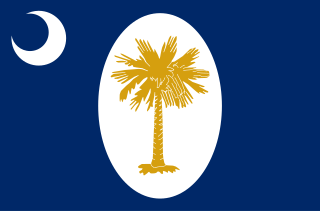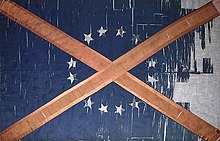
The Confederate States of America (CSA), commonly referred to as the Confederate States (C.S.), the Confederacy, or the South, was an unrecognized breakaway republic in the Southern United States that existed from February 8, 1861, to May 9, 1865. The Confederacy comprised eleven U.S. states that declared secession and warred against the United States during the American Civil War. The states were South Carolina, Mississippi, Florida, Alabama, Georgia, Louisiana, Texas, Virginia, Arkansas, Tennessee, and North Carolina.

The flag of Scotland is the national flag of Scotland, which consists of a white saltire defacing a blue field. The Saltire, rather than the Royal Standard of Scotland, is the correct flag for all private individuals and corporate bodies to fly. It is also, where possible, flown from Scottish Government buildings every day from 8:00 am until sunset, with certain exceptions.

The flags of the Confederate States of America have a history of three successive designs during the American Civil War. The flags were known as the "Stars and Bars", used from 1861 to 1863; the "Stainless Banner", used from 1863 to 1865; and the "Blood-Stained Banner", used in 1865 shortly before the Confederacy's dissolution. A rejected national flag design was also used as a battle flag by the Confederate Army and featured in the "Stainless Banner" and "Blood-Stained Banner" designs. Although this design was never a national flag, it is the most commonly recognized symbol of the Confederacy.

A saltire, also called Saint Andrew's Cross or the crux decussata, is a heraldic symbol in the form of a diagonal cross. The word comes from the Middle French sautoir, Medieval Latin saltatoria ("stirrup").

The flag of Georgia is the flag of the U.S. state of Georgia. Its current iteration was adopted on February 19, 2003. The flag bears three horizontal stripes and features a blue canton containing a ring of 13 white stars that encircle the state's gold-colored coat of arms. The ring of stars that encompass the state's coat of arms represents Georgia as one of the original Thirteen Colonies.

The flags of the U.S. states, territories, and the District of Columbia exhibit a variety of regional influences and local histories, as well as different styles and design principles. Modern U.S. state flags date from the turn of the 20th century, when states considered distinctive symbols for the 1893 World's Columbian Exposition in Chicago, Illinois. Most U.S. state flags were designed and adopted between 1893 and World War I.

The flag of Florida consists of a red saltire on a white background, with the state seal superimposed on the center. The flag's current design has been in use since May 21, 1985, after the design of the Florida state seal was graphically improved and officially sanctioned for use by state officials.

The flag of Mississippi consists of a white magnolia blossom surrounded by 21 stars and the words 'In God We Trust' written below, all put over a blue Canadian pale with two vertical gold borders on a red field. The topmost star is composed of a pattern of five diamonds, an Indigenous symbol; the other 20 stars are white, as Mississippi was the 20th state to join the Union. The flag was adopted on January 11, 2021.

The flag of Oklahoma, also known as the Oklahoma flag, is a rectangular field of sky blue on which is placed an Osage war shield with six crosses and seven pendant eagle feathers above the word 'Oklahoma' in white. Superimposed onto the crosses of the war shield is a calumet and an olive branch.

The flag of Great Britain, commonly known as King's Colours, the first Union Flag, the Union Jack, or the British flag, was used at sea from 1606 and more generally from 1707 to 1801. It was the first flag of the Kingdom of Great Britain. It is the precursor to the Union Jack of 1801.

William Porcher Miles was an American politician who was among the ardent states' rights advocates, supporters of slavery, and Southern secessionists who came to be known as the "Fire-Eaters." He is notable for having designed the most popular variant of the Confederate flag, originally rejected as the national flag in 1861 but adopted as a battle flag by the Army of Northern Virginia under General Robert E. Lee before it was reincorporated.

The Alabama State Capitol, listed on the National Register of Historic Places as the First Confederate Capitol, is the state capitol building for Alabama. Located on Capitol Hill, originally Goat Hill, in Montgomery, it was declared a National Historic Landmark on December 19, 1960. Unlike every other state capitol, the Alabama Legislature does not meet there, but at the Alabama State House. The Capitol has the governor's office and otherwise functions as a museum.

The coat of arms of Alabama depicts a shield upon which is carried the symbols of the five states which have at various times held sovereignty over a part or the whole of what is now Alabama. These are the ancient coat of arms of France, the ancient coat of arms of Crown of Castile for Spain, the modern Union Jack of the United Kingdom and the battle flag of the Confederate States. On an escutcheon of pretence is borne the shield of the United States. The crest of the coat represents a ship which brought the French colonists who established the first permanent European settlements in the territory. Below is the state motto: Audemus jura nostra defendere, meaning "We dare defend our rights."

Saint Patrick's Saltire or Saint Patrick's Cross is a red saltire on a white field. In heraldic language, it may be blazoned argent, a saltire gules. Saint Patrick's Flag is a flag composed of Saint Patrick's Saltire. The origin of the saltire is disputed. Its association with Saint Patrick dates from the 1780s, when the Anglo-Irish Order of Saint Patrick adopted it as an emblem. This was a British chivalric order established in 1783 by George III. It has been suggested that it derives from the arms of the powerful Geraldine or FitzGerald dynasty. Some Irish nationalists and others reject its use to represent Ireland as a "British invention" "for a people who had never used it".

Florida participated in the American Civil War as a member of the Confederate States of America. It had been admitted to the United States as a slave state in 1845. In January 1861, Florida became the third Southern state to secede from the Union after the November 1860 presidential election victory of Abraham Lincoln. It was one of the initial seven slave states which formed the Confederacy on February 8, 1861, in advance of the American Civil War.

Alabama was central to the Civil War, with the secession convention at Montgomery, the birthplace of the Confederacy, inviting other slaveholding states to form a southern republic, during January–March 1861, and to develop new state constitutions. The 1861 Alabaman constitution granted citizenship to current U.S. residents, but prohibited import duties (tariffs) on foreign goods, limited a standing military, and as a final issue, opposed emancipation by any nation, but urged protection of African-American slaves with trials by jury, and reserved the power to regulate or prohibit the African slave trade. The secession convention invited all slaveholding states to secede, but only 7 Cotton States of the Lower South formed the Confederacy with Alabama, while the majority of slave states were in the Union. Congress had voted to protect the institution of slavery by passing the Corwin Amendment on March 4, 1861, but it was never ratified.

South Carolina was the first state to secede from the Union in December 1860, and was one of the founding member states of the Confederacy in February 1861. The bombardment of the beleaguered U.S. garrison at Fort Sumter in Charleston Harbor on April 12, 1861, is generally recognized as the first military engagement of the war. The retaking of Charleston in February 1865, and raising the flag again at Fort Sumter, was used for the Union symbol of victory.

Georgia was one of the original seven slave states that formed the Confederate States of America in February 1861, triggering the U.S. Civil War. The state governor, Democrat Joseph E. Brown, wanted locally raised troops to be used only for the defence of Georgia, in defiance of Confederate president Jefferson Davis, who wanted to deploy them on other battlefronts. When the Union blockade prevented Georgia from exporting its plentiful cotton in exchange for key imports, Brown ordered farmers to grow food instead, but the breakdown of transport systems led to desperate shortages.

Although the Confederate States of America dissolved at the end of the American Civil War (1861–1865), its battle flag continues to be displayed as a symbol. The modern display began during the 1948 United States presidential election when it was used by the Dixiecrats, a political party that opposed civil rights for African Americans. Further display of the flag was a response to the civil rights movement and the passage of federal civil rights laws in the 1950s and 1960s.

The 2001 Mississippi flag referendum was a legislatively referred state statute appearing on an April 17, 2001 special election ballot, an election held specifically for this referendum.



























